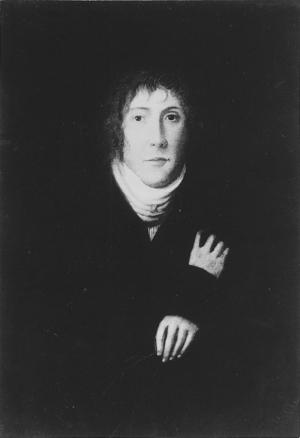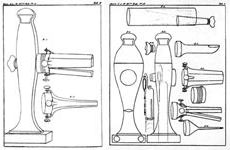Philipp Bozzini on:
[Wikipedia]
[Google]
[Amazon]
 Philipp Bozzini (May 25, 1773 – April 4, 1809) was born in
Philipp Bozzini (May 25, 1773 – April 4, 1809) was born in
 In 1798 he married Margarete Reck, and they had three children.
During the
In 1798 he married Margarete Reck, and they had three children.
During the
"Lichtleiter, eine Erfindung zur Anschauung innerer Teile und Krankheiten, nebst der Abbildung"
(Light conductor, an invention for viewing internal parts and diseases, together with illustrations), ''Journal der practischen Arzneykunde und Wundarzneykunst'' (Journal of Practical Medicine and Surgery), 24 : 107-124. 2. Philipp Bozzini
''Der Lichtleiter oder die Beschreibung einer einfachen Vorrichtung und ihrer Anwendung zur Erleuchtung innerer Höhlen und Zwischenräume des lebenden animalischen Körpers''
he light conductor, or description of a simple instrument and its use for illuminating inner cavities and intersticies of the living animal body(Weimar, (Germany): Industrie Comptoirs, 1807). 3. Désormeaux MAS (1855) De l´endoscope, instrument propre à éclairer certaines cavités intérieures de l´économie. Comptes Rendus Hébdomadaires des Séances de l´Academie des Sciences 40:692. 4. Désormeaux MAS (1865) De l´endoscope et de ses applications au diagnostic et au traitement des affections de l'urètre et de la vaissie. Baillière Paris. 5. Figdor PP (2001) Philipp Bozzini. Endo-Press, Tuttlingen, Germany. 6. Grünfeld J (1879) Zur Geschichte der Endoskopie und der endoskopischen Apparate. Med Jahrb, Wien, Austria S 237-291. 7. Hauri D. A look inside the bladder—the human behind it. Der Urologe A 2005.44(4):401-407. ubMed 8. Mann G. Altes Neues Philipp Bozzini (1773–1809). Medizinhist 1972;7:201-203. ubMed 9. Reuter HJ, Reuter MA (1988) Bozzini und die Endoskopie des 19.Jahrhunderts. Thieme-Stuttgart-Germany. 10. Reuter MA (1998) Geschichte der Endoskopie. Krämer, Stuttgart, Germany. 11. Reuter MA (2004) Entwicklung der Urologie. Springer, Berlin, Heidelberg, New York. 12. Reuter MA Philipp Bozzini (1773–1809): The endoscopic idealist]. Der Urologe A 2006.45(9):1084-1091. ubMed 13. Roediger E (1990) Der Frankfurter Arzt Philipp Bozzini, der Erfinder des Lichtleiters (1773–1809). Alt Frankfurt 1: 46-55 (reprint:1972 Medizinhist J7:204-217. 14. Ségalas M. Description of an instrument for inspecting the urethra and bladder. Lancet 1827;7:603. {{DEFAULTSORT:Bozzini, Philipp 18th-century German physicians Physicians from Frankfurt Physicians from Mainz German anatomists 1773 births 1809 deaths Endoscopy Deaths from typhus 19th-century German inventors
 Philipp Bozzini (May 25, 1773 – April 4, 1809) was born in
Philipp Bozzini (May 25, 1773 – April 4, 1809) was born in Mainz
Mainz () is the capital and largest city of Rhineland-Palatinate, Germany.
Mainz is on the left bank of the Rhine, opposite to the place that the Main (river), Main joins the Rhine. Downstream of the confluence, the Rhine flows to the north-we ...
, Germany
Germany,, officially the Federal Republic of Germany, is a country in Central Europe. It is the second most populous country in Europe after Russia, and the most populous member state of the European Union. Germany is situated betwe ...
. On June 12, 1797 he was awarded the degree of doctor of medicine. From 1804 onwards, Bozzini devoted himself virtually completely to develop his instrument, Lichtleiter or "Light Conductor", a primitive endoscope
An endoscope is an inspection instrument composed of image sensor, optical lens, light source and mechanical device, which is used to look deep into the body by way of openings such as the mouth or anus. A typical endoscope applies several modern t ...
to allow for inspecting the ear, urethra, rectum, female bladder, cervix, mouth, nasal cavity, or wounds. Philipp Bozzini, using the modest means available at the beginning of the 19th century, was able to show to the medical profession the way to endoscopy. With his instrument and ideas, he was three quarters of a century ahead of the technical and scientific possibilities of his time. Historians agree that this instrument using artificial light and various mirrors and specula was the beginning of a large family of endoscopes.
Early life
Philipp Bozzini was born on May 25, 1773 in Mainz, Germany. His father, Nicolaus Maria Bozzini de Bozza, came from a well-to-do Italian family that had to escape from Italy in approximately 1760 as the result of a duel. In Mainz, Nicolaus entered into business and married Anna Maria Florentin de Cravatte, from the city of Frankfurt. Bozzini started his medical studies in Mainz, and approximately in 1794 went toJena
Jena () is a German city and the second largest city in Thuringia. Together with the nearby cities of Erfurt and Weimar, it forms the central metropolitan area of Thuringia with approximately 500,000 inhabitants, while the city itself has a popu ...
to complete them. On June 12, 1797 Bozzini was granted the title of doctor of medicine, which allowed him to establish in Mainz as physician
A physician (American English), medical practitioner (Commonwealth English), medical doctor, or simply doctor, is a health professional who practices medicine, which is concerned with promoting, maintaining or restoring health through th ...
. Soon afterwards, he traveled several times to France and the Netherlands in order to acquire professional experience.
Later life
 In 1798 he married Margarete Reck, and they had three children.
During the
In 1798 he married Margarete Reck, and they had three children.
During the War of the Second Coalition
The War of the Second Coalition (1798/9 – 1801/2, depending on periodisation) was the second war on revolutionary France by most of the European monarchies, led by Britain, Austria and Russia, and including the Ottoman Empire, Portugal, N ...
against France, Bozzini served in the imperial army and was in charge of a 120-bed campaign hospital in Mainz. His extraordinary merits during this time were known by the Archduke Karl of Austria
Archduke Charles Louis John Joseph Laurentius of Austria, Duke of Teschen (german: link=no, Erzherzog Karl Ludwig Johann Josef Lorenz von Österreich, Herzog von Teschen; 5 September 177130 April 1847) was an Austrian field-marshal, the third s ...
(1771–1847), who would protect in the future Bozzini’s invention. Bozzini thought that the instrument could be incorporated into Austrian military hospitals. This required a device to be sent to Wien, and also the performance of an expertise by health authorities. An investigating committee subjected the instrument to various tests, starting with examination in corpses of the bladder, rectum, vagina, and peritoneal cavity through small laparotomies. The committee proposed some changes intended to improve the performance of the light conductor. Once such changes were made, they were satisfied with the operation of the instrument in patients (only examinations of the peritoneal cavity were not approved), particularly also because the procedure was painless.
Due to intrigues in the upper governmental spheres, a second expertise was decided, this time at the Wien medical school, which performed it, and partly under the negative influence of the church, as the report turned out to be unfavorable for Bozzini and concluded that such an instrument should not be used.
The second coalition war ended with the 1801 Luneville peace treaty between Napoleon and Kaiser Franz, and the left bank of the Rhine river remained in the hands of the French. The new Mainz government granted young Bozzini authorization to practice his profession, but he refused to accept the French citizenship and therefore decided to establish himself at Frankfurt.
Activities in Frankfurt
Bozzini’s knowledge of mathematics, philosophy, and chemistry was outstanding. Aeronautic studies and drawings of a flying device were unfortunately lost. His exceptional talent as an artist and drawer is shown by his monograph about the “light conductor”, where a self-portrait and watercolor paintings about the instrument may be seen. Like many idealist people, Bozzini had no experience in business matters, but devoted himself with enthusiasm to his scientific activities. From 1804 on, his dedication to the development of his instrument for endoscopy was virtually complete. To earn a living, Bozzini practiced obstetrics with extreme care. On May 30, 1808 he was granted the title of “Physicus extraordinarius” at the request of one of his patients,Karl Theodor von Dalberg
Karl Theodor Anton Maria von Dalberg (8 February 1744 – 10 February 1817) was Prince- Archbishop of Regensburg, Arch-Chancellor of the Holy Roman Empire, Bishop of Constance and Worms, prince-primate of the Confederation of the Rhine and ...
, a personality of great influence in the region.
Bozzini was one of the four physicians of the city of Frankfurt who should also care for the surrounding peasant areas while being a “plague” physician.
Death
The various tasks in Frankfurt were not only tedious for these physicians, but also dangerous. His predecessor in the position, Dr. Zeitmann, had died during one of the epidemic outbreaks of typhus in the region. Bozzini contracted the same disease around mid-March 1809, after successfully treating 42 patients with typhus. His friend and colleague Feyerlein subsequently reported the dedication with which he cared of his patients, disregarding the risk of contagion he had. On April 4, 1809, Bozzini died from that infection at 36 years of age. He left his wife in a bad financial situation. She died six months later. Their three small children were given over to friends.Legacy
When theFrankfurt Cathedral
Frankfurt Cathedral (german: link=no, Frankfurter Dom), officially Imperial Cathedral of Saint Bartholomew (german: link=no, Kaiserdom Sankt Bartholomäus) is a Roman Catholic Gothic church located in the heart of Frankfurt am Main, Germany. It ...
was renovated after the war, in 1954, the gravestone to the memory of Bozzini was uncovered; the words dedicated to him by his friend Feyerlein may still be read in it:
“To the devote soul of Philipp Bozzini, doctor of medicine, who was the first to explore the inside of organs through his ingenious light projector. He was able to tenaciously fight fever in other people, with a great sense of duty, and succumbed on the night from the 4th to the 5th day of April 1809, in his 36th year of life. His faithful friend F.F."
See also
Antonin Jean Desormeaux
Antonin Jean Desormeaux (25 December 1815 – October 1894) was a 19th-century French physician and inventor who has been called the "father of endoscopy", because he made significant improvements to the early endoscope and was the first to succe ...
References
1. Bozzini (1806"Lichtleiter, eine Erfindung zur Anschauung innerer Teile und Krankheiten, nebst der Abbildung"
(Light conductor, an invention for viewing internal parts and diseases, together with illustrations), ''Journal der practischen Arzneykunde und Wundarzneykunst'' (Journal of Practical Medicine and Surgery), 24 : 107-124. 2. Philipp Bozzini
''Der Lichtleiter oder die Beschreibung einer einfachen Vorrichtung und ihrer Anwendung zur Erleuchtung innerer Höhlen und Zwischenräume des lebenden animalischen Körpers''
he light conductor, or description of a simple instrument and its use for illuminating inner cavities and intersticies of the living animal body(Weimar, (Germany): Industrie Comptoirs, 1807). 3. Désormeaux MAS (1855) De l´endoscope, instrument propre à éclairer certaines cavités intérieures de l´économie. Comptes Rendus Hébdomadaires des Séances de l´Academie des Sciences 40:692. 4. Désormeaux MAS (1865) De l´endoscope et de ses applications au diagnostic et au traitement des affections de l'urètre et de la vaissie. Baillière Paris. 5. Figdor PP (2001) Philipp Bozzini. Endo-Press, Tuttlingen, Germany. 6. Grünfeld J (1879) Zur Geschichte der Endoskopie und der endoskopischen Apparate. Med Jahrb, Wien, Austria S 237-291. 7. Hauri D. A look inside the bladder—the human behind it. Der Urologe A 2005.44(4):401-407. ubMed 8. Mann G. Altes Neues Philipp Bozzini (1773–1809). Medizinhist 1972;7:201-203. ubMed 9. Reuter HJ, Reuter MA (1988) Bozzini und die Endoskopie des 19.Jahrhunderts. Thieme-Stuttgart-Germany. 10. Reuter MA (1998) Geschichte der Endoskopie. Krämer, Stuttgart, Germany. 11. Reuter MA (2004) Entwicklung der Urologie. Springer, Berlin, Heidelberg, New York. 12. Reuter MA Philipp Bozzini (1773–1809): The endoscopic idealist]. Der Urologe A 2006.45(9):1084-1091. ubMed 13. Roediger E (1990) Der Frankfurter Arzt Philipp Bozzini, der Erfinder des Lichtleiters (1773–1809). Alt Frankfurt 1: 46-55 (reprint:1972 Medizinhist J7:204-217. 14. Ségalas M. Description of an instrument for inspecting the urethra and bladder. Lancet 1827;7:603. {{DEFAULTSORT:Bozzini, Philipp 18th-century German physicians Physicians from Frankfurt Physicians from Mainz German anatomists 1773 births 1809 deaths Endoscopy Deaths from typhus 19th-century German inventors